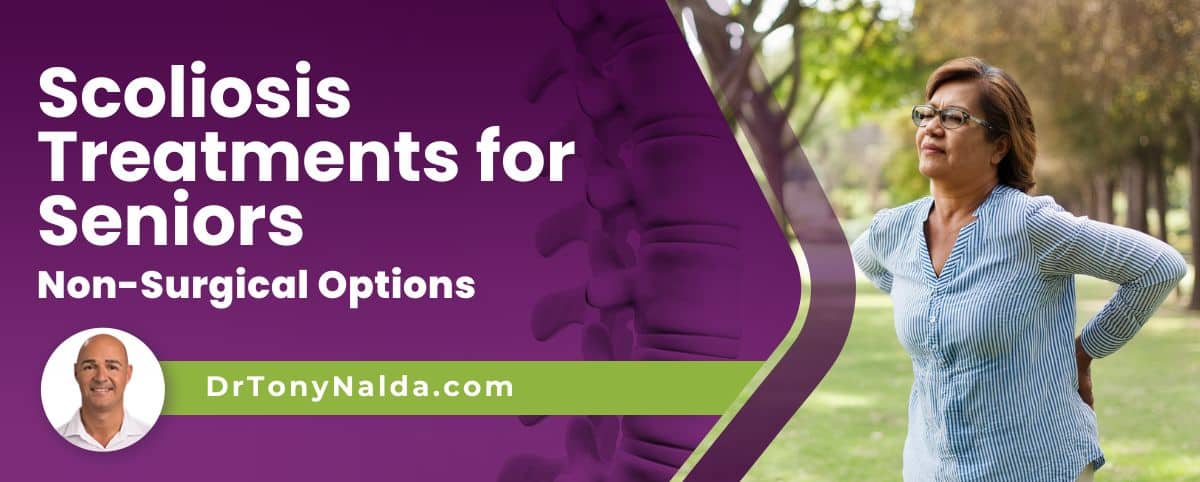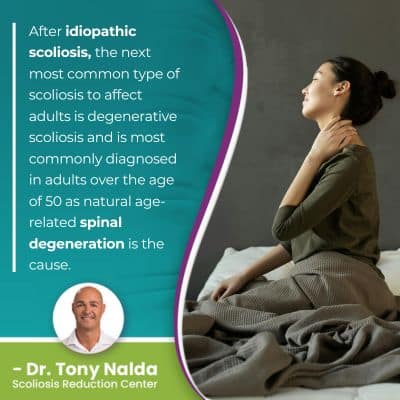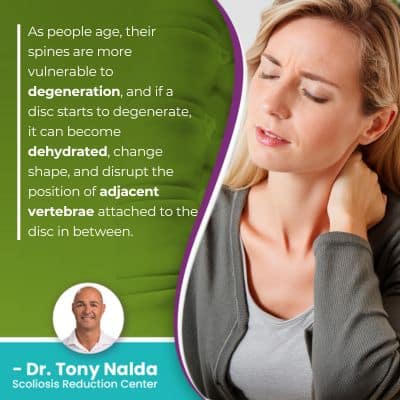Scoliosis Treatments for Seniors: Non-Surgical Options

The main type of scoliosis to affect seniors is degenerative scoliosis, and this type is caused by natural age-related spinal degeneration and the cumulative effect of certain lifestyle factors. At any age, scoliosis can be progressive, so the best time to start treatment is always now.
Patient age is an important factor when it comes to customizing effective treatment plans. Scoliosis treatment has a different focus with different age groups, and when it comes to seniors, nonsurgical treatment focuses on stabilizing the spine, improving its flexibility, muscle strengthening, and pain relief.
Scoliosis treatments for seniors focus on stabilizing the spine, so let's start with how scoliosis makes the spine increasingly unstable and unbalanced.
Table of Contents
Adult Scoliosis
Scoliosis causes the spine to bend unnaturally to the side and twist, and as a progressive condition, its nature is to get worse over time; as the condition progresses, it's introducing more and more uneven forces to the spine, its surrounding muscles and nerves, and the entire body.
The spine becomes more unbalanced and unstable as the size of the unnatural spinal curve increases, and it's growth that triggers progression.
Scoliosis ranges widely in severity from mild scoliosis to moderate scoliosis, severe and very severe scoliosis, and scoliosis can affect all ages, although its most prevalent type is adolescent idiopathic scoliosis, diagnosed between the ages of 10 and 18.
Scoliosis does, however, also affect adults and the two most common types diagnosed in adults are idiopathic scoliosis and degenerative scoliosis.
Idiopathic Scoliosis in Adults
 Idiopathic scoliosis in adults are cases of adolescent idiopathic scoliosis that went undiagnosed and untreated during adolescence; this is a common scenario as scoliosis isn't always easy to detect and diagnose in children.
Idiopathic scoliosis in adults are cases of adolescent idiopathic scoliosis that went undiagnosed and untreated during adolescence; this is a common scenario as scoliosis isn't always easy to detect and diagnose in children.
For children and adolescents, scoliosis isn't commonly painful, and this is because the condition doesn't become compressive until skeletal maturity has been reached; growing spines are constantly being lengthened during growth, and this counteracts the compressive force of the unnatural spinal curve.
It's compression of the spine and its surrounding muscles and nerves that cause the majority of condition-related pain.
So for adolescents, the lack of pain can make the condition harder to diagnose, and particularly when mild, postural changes, that are the condition's main effect in children, can be subtle.
Adolescents with scoliosis can live with the condition for years before realizing something is wrong, and this is often once the condition has progressed with time and maturity, becoming noticeable when growth has stopped and conditions become compressive and painful.
The lack of scoliosis pain in children can be a barrier to early diagnosis, but this isn't the case with older adults; pain is the main scoliosis symptom that brings adults in to see me for a diagnosis and treatment.
Scoliosis pain can involve the muscles, affected spinal section, and the section's surrounding muscles and nerves.
In most cases of scoliosis, the are of the body located the closest to the affected spinal section is going to be feel the majority of the condition's direct effects; for example, a common complication of lumbar scoliosis in older adults is sciatic nerve pain because the sciatic nerve starts in the lumbar spine, and compression can irritate the sciatic nerve.
When adults develop scoliosis fresh in adulthood with no prior history with the condition, this is known as de novo scoliosis.
Degenerative Scoliosis in the Elderly
After idiopathic scoliosis, the next most common type of scoliosis to affect adults is degenerative scoliosis and is most commonly diagnosed in adults over the age of 50 as natural age-related spinal degeneration is the cause.
Spinal degenerative changes is why the actual rate of scoliosis increases in the aging population, even though it's more commonly diagnosed in children.
There is a certain amount of spinal degeneration to be expected with age, but the cumulative effect of lifestyle factors can play a role in the rate and level of age-related changes.
Carrying excess weight puts added strain on the body's joints, including the spine, and this can cause adverse spinal tension and uneven wear and tear.
Leading a sedentary lifestyle is contrary to the spine's movement-based design and can cause spinal rigidity and weak core muscles, meaning the spine is not adequately supported and stabilized.
Chronic poor posture can also introduce compression and adverse spinal tension to the spine's vertebrae and intervertebral discs.
Excessive consumption of alcohol and/or smoking can also contribute to disc desiccation and degenerative changes.
People with occupations that involve repeatedly lifting heavy objects and don't do so properly can repeatedly strain the back, weaken it, and expose it to injury.
Disc Degeneration
In many cases of degenerative scoliosis, degeneration starts in the discs, and the discs that sit between adjacent vertebrae have many important roles: giving the spine structure, flexibility, cushioning, and acting as the spine's shock absorbers.
 As people age, their spines are more vulnerable to degeneration, and if a disc starts to degenerate, it can become dehydrated, change shape, and disrupt the position of adjacent vertebrae attached to the disc in between.
As people age, their spines are more vulnerable to degeneration, and if a disc starts to degenerate, it can become dehydrated, change shape, and disrupt the position of adjacent vertebrae attached to the disc in between.
The more degeneration, the more unnaturally tilted the vertebrae become, and the more unstable and unbalanced the spine becomes over time.
As seniors also tend to experience muscle loss, this can also mean the spine isn't being supported and stabilized by its surrounding muscles: another factor affecting the development of degenerative scoliosis is older adults.
Females are also more likely to develop degenerative scoliosis than males of the same age, and this is the result of changes to bone density and hormones related to menopause.
So how is degenerative scoliosis in the elderly treated?
Conservative Scoliosis Treatment Options for Seniors
Here at the Scoliosis Reduction Center®, all ages benefit from a nonsurgical conservative treatment approach, and while a priority of treatment for younger patients is achieving a significant curvature reduction to counteract progression, the focus with seniors is different.
A goal of treatment is always reducing the size of a scoliotic curve, but as adults are no longer growing, there is more time to work, and the focus is more about reducing the size of the curve back to where it was prior to becoming painful.
Remember, pain is the main symptom of scoliosis in adults of all ages because the condition is compressive.
Scoliosis pain for adults can include muscle pain, localized back pain, and pain that radiates into the extremities due to nerve compression.
As the spine becomes increasingly unstable, it will progress and degenerate faster, so a focus when treating scoliosis in the elderly is to improve the spine's support and stability.
Conservative treatment uses gentle and precise chiropractic adjustments to work towards repositioning the curve's most-tilted vertebrae; even a small improvement in the spine's alignment can make a big difference in terms of stability.
Physical therapy and scoliosis exercises can also play a large role in increasing the spine's support and stability by making its surrounding muscles stronger and more balanced so they can optimally support and stabilize the spine and support its healthy curves and alignment.
Scoliosis bracing is used to augment corrective treatment results in growing spines, but when used in the treatment of adult scoliosis, particularly senior scoliosis, it can be used for short-term pain relief and stability.
Changes can be worked towards slowly in treatment, but as all forms of scoliosis are progressive, the goal is to preserve spinal function and strength while preventing further degenerative changes, so being proactive is important, and this means starting treatment as close to the time of diagnosis as possible.
Conclusion
While surgery can address scoliosis in older adults, there are always risks associated with surgical procedures, and spinal surgery can be particularly risky, and spinal fusion is invasive.
The risks of spinal fusion increase with age and each additional surgical procedure, so a more natural less-invasive treatment option in the form of conservative treatment can help improve older patients' quality of life.
As conservative treatment plans are customized to address the needs of each individual patient, chiropractic care and physical therapy can be easily modified to suit an older patient's condition and ability.
It's never too late to work towards improvement, and this can be achieved through making improvements to the spine's alignment, strength, balance, support, and stability, and these changes will provide pain relief as the underlying cause of scoliosis pain is being addressed: the condition itself.
Seniors are most often diagnosed with degenerative scoliosis as it's caused by natural age-related spinal degeneration that commonly starts with degenerative disc disease and the cumulative effect of negative lifestyle factors.
When degenerative scoliosis is diagnosed here at the Center, treatment focuses on how to preserve spinal function, prevent further degeneration, and improve spinal alignment, support, and stability.
Dr. Tony Nalda
DOCTOR OF CHIROPRACTIC
After receiving an undergraduate degree in psychology and his Doctorate of Chiropractic from Life University, Dr. Nalda settled in Celebration, Florida and proceeded to build one of Central Florida’s most successful chiropractic clinics.
His experience with patients suffering from scoliosis, and the confusion and frustration they faced, led him to seek a specialty in scoliosis care. In 2006 he completed his Intensive Care Certification from CLEAR Institute, a leading scoliosis educational and certification center.
About Dr. Tony Nalda
 Ready to explore scoliosis treatment? Contact Us Now
Ready to explore scoliosis treatment? Contact Us Now





